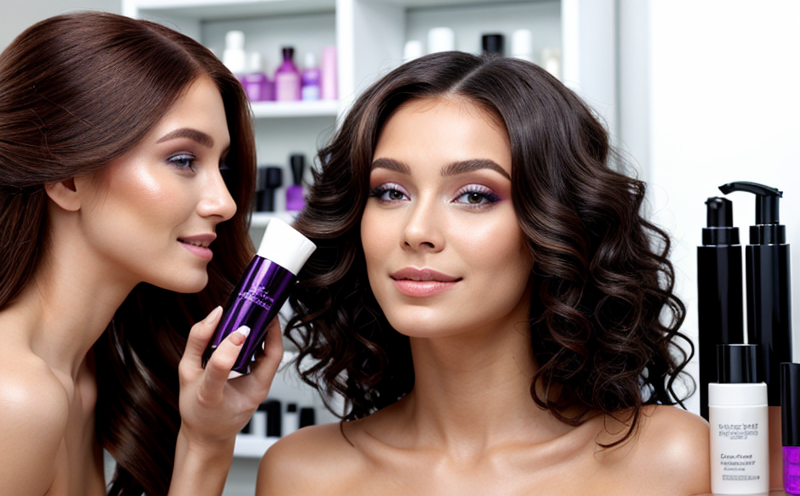Hair Volume Enhancement Testing in Styling Products
Testing hair volume enhancement in styling products is a critical process that ensures the quality and effectiveness of hair care formulations. This testing serves to evaluate whether a product can achieve its intended purpose, which is to increase the perceived or actual volume of the user's hair. The testing methodology involves several steps, including sample preparation, application procedures, and evaluation metrics.
The first step in this process is proper sample preparation. Hair samples are typically collected from individuals with similar characteristics to those who would use the product, ensuring a representative sample set for analysis. Preparing the hair can involve washing it according to specified protocols to remove any natural oils or residues that could affect test results.
After preparing the samples, they undergo treatment with the styling product being tested. The application process is carefully controlled, following standardized procedures that may include specific volumes of product and time intervals for drying or heat setting. This ensures consistency across different samples and testing conditions.
The evaluation of hair volume enhancement involves both visual assessment and quantitative measurement techniques. Visual assessments are often subjective but provide valuable insights into the perceived change in hair volume. Quantitative measurements can be made using tools such as digital imaging systems that capture before-and-after images of the treated hair, allowing for accurate comparisons.
International standards like ISO 21053:2018 and ASTM D7694 provide guidelines on how to conduct these tests effectively. These standards outline specific procedures for sample preparation, application methods, and evaluation criteria, ensuring that all testing laboratories follow consistent protocols.
The importance of this testing cannot be overstated in the cosmetics industry. Hair volume enhancement is a key feature that consumers look for when purchasing styling products, and reliable test results ensure that these products meet market expectations. By adhering to rigorous testing procedures, manufacturers can develop high-quality hair care formulations that deliver the desired effects consistently.
Consistency in hair volume enhancement across different lots of product is essential for brand reputation and consumer satisfaction. Therefore, thorough quality control measures are implemented throughout the manufacturing process, including regular testing at various stages from formulation to finished goods.
In conclusion, conducting hair volume enhancement tests on styling products is vital for ensuring product efficacy and meeting regulatory requirements. It helps manufacturers produce reliable and effective hair care products that meet consumer needs while maintaining high standards of quality assurance.
Why It Matters
The quality of hair volume enhancement in styling products directly impacts consumer satisfaction and brand reputation. Consumers expect products that deliver the promised effects consistently, and failing to meet these expectations can lead to customer dissatisfaction and potential loss of market share.
- Consumer trust is paramount in the cosmetics industry, and reliable test results build this trust.
- Rigorous testing ensures that products perform as advertised, enhancing brand credibility.
- Consistent quality across different batches helps maintain product consistency, which is crucial for customer loyalty.
From a regulatory perspective, compliance with international standards like ISO 21053:2018 and ASTM D7694 ensures that the testing process meets legal requirements. This not only protects manufacturers from potential penalties but also facilitates smoother market entry into various regions.
In summary, reliable hair volume enhancement testing is essential for maintaining high-quality standards in the cosmetics industry. It enhances consumer trust, supports brand reputation, and ensures compliance with international regulations.
Quality and Reliability Assurance
- Sample Preparation: Ensuring that all samples are prepared uniformly according to specified protocols is crucial for consistent test results. This includes washing the hair with standardized detergents, drying it to a specific humidity level, and conditioning it if necessary.
- Product Application: The application of styling products must be done precisely following pre-determined procedures. This ensures that all samples receive identical treatment, which is vital for comparing results accurately.
Rigorous quality control measures are essential to maintain consistency across different batches and ensure reliable test outcomes. These measures include regular calibration of equipment used in the testing process and strict adherence to standard operating procedures (SOPs).
By implementing these robust quality assurance protocols, laboratories can provide accurate and consistent results that are trusted by both manufacturers and regulatory bodies.
International Acceptance and Recognition
- Compliance with Standards: Adherence to international standards such as ISO 21053:2018 and ASTM D7694 ensures that test results are consistent, reliable, and accepted worldwide. These standards provide clear guidelines on sample preparation, application methods, and evaluation criteria.
- Interlaboratory Comparability: By following internationally recognized protocols, laboratories can ensure that their results are comparable across different countries and regions, facilitating easier market entry for cosmetic products.
The acceptance of test results in multiple jurisdictions is crucial for expanding a brand's global reach. Compliance with these standards not only enhances credibility but also streamlines the regulatory process, making it easier to obtain approvals from various national authorities.
In conclusion, ensuring international acceptance and recognition through adherence to recognized standards is vital for the success of cosmetic product testing in an increasingly globalized market.





